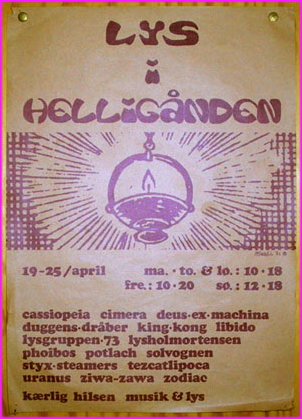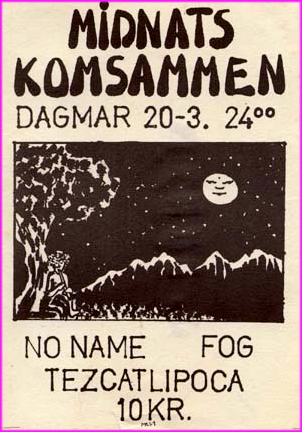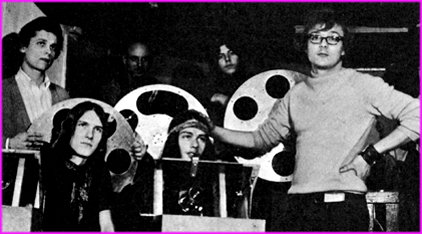Tezcatlipoca Lights |
Personnel: Mikkel Scharff (the chronicler): wet & colour slides, switch boards
Equipment: Furthermore an abundance of small motors running color wheels, special effect wheels, prisms, and still more. Venues Klub 27 (at three locations over a span of a few years: Technique: Colored liquids used for "wet slides" were basically aqueous or oil-based. The main type of oil used were rhicinus oil, mixed with a variety of colorants such as methylene blue, "Organol" yellow and blue, as well as others to form all the basic colors (black, red, blue, green, yellow). Various off-the-shelf inks (brand "Pelikan") were used as the aqueous, colored component of wet slides. Wet slides to be used in ordinary, manually operated - today considered very old-fashioned - slide projectors were used intensively. Wet slides were made by means of five by five cm (2" by 2") slide glasses (used before modern plastic - or cardboard - slide frames became commonplace). One glass was laid on a table, e.g. an outer ring of oil-based color was applied (sometimes with a smaller ring near the center of the glass), and an aqueous ink in another color was put in between. Yet a piece of glass was put on top of the liquid colors and the "wet slide" was immediately transferred to the slide projector. Another variation that I believe I learned from another light show performer (a "lysmand", i.e. "light man" as was then the common term!) named Søren Danielsen consisted of adding to the aqueous phase of a "wet slide" a few drops of a household glue (brand "Dana Lim"). This particular glue - when heated in the slide projector - then began to emit minute bubbles in the ink, bubbles not unlike the minute bubbles that stems from dishwasher soaps when in use in the kitchen sink! Quite spectacular - thanks again for the advice, Søren! The development of bubbles and the speed of the development was closely related to guiding a proper amount of heat towards and away from the wet slide. The Aldus slide projectors had - like most other slide projectors - two ways of avoiding excess heat reaching the slide during normal use: A filter made of lead glass between the slide and the bulb and a fan streaming cold air past the slide. In our case - wanting to make deliberate use of controlled amounts of heat - we had removed the lead glass from all projectors. To control the amount of heat reaching the "wet slide" we deliberately blocked the air stream when we needed heat to propagate bubbles and opened up the air stream again when we wanted to slow down the development of bubbles. The Noris projectors were rebuild to be used as overhead projectors. Frank and Lars did a marvellous job with these projectors, mounting them vertically in a box (i.e., the lenses facing upwards), using a 45 degree-mounted mirror to project the images towards the screen behind the musicians. The level of the slides were completely rebuild to hold two small watch glasses between which the colored liquids were manipulated by Frank and Lars during the performances. A large number of color slides, photographed with the purpose of being used in the light show, were used in the four slide projectors. Slides were usually in series of two or four, making it possible to "paint" the entire background (behind wet slides or overhead projections) with a continuous subject, a landscape for example. Furthermore, a number of slides were produced by copying graphic materials - e.g. geometric patterns or black-and-white old prints. By means of the switchboard, all slide projectors or only two by two could be made to change at the same time, or dimmed in or out. For the regular performances at "Klub 27" we build two "towers" of wood on which equipment could be placed above the heads of the public sitting, standing and sometimes dancing on the floor between the light show at the back of the room and the bandstand. The very beginning of what was later to become Tezcatlipoca Lights originated from various events that took place during the fall of 1968 (as well as the chronicler remembers). Then, a little more than a year after, a somewhat provincial version the "Summer of Love" took place in Copenhagen, Denmark, with various local events in among others "Kongens Have" (The King's Garden in central Copenhagen) and "Langelinie" (a picturesque area in the harbour of Copenhagen). The events included free-style jam sessions with the local hippies (dressed as such), wearing flowers, or open-air concerts with some of the first sub-culture bands. Such events were certainly - although we later learned, only remotely - mimicking what was learned about similar events in f.i. San Francisco, USA, or "Swinging London", UK - then some of the centres of what came to be known as hippie lifestyle and psychedelic music. Obviously, it was rather limited what could be learned about the details of this new culture and music. Only few Danes had first-hand knowledge about these phenomena, actually rooted in the 1950s beatnic culture on the West coast of the US. Reports in the mainstream press and most other media were only worth a laugh. But indirectly - or through more reliable sources - information could be gathered. A few alternative record-shops appeared, specializing in direct import of this new music and various paraphernalia (posters, imported alternative music magazines or hippie magazines, etc.). These imported LP-records were completely different to the types of records available in regular record shops, featuring groups and single artists at the same time as they could be read about in the alternative magazines. A few Danish, alternative magazines also emerged - often linked to the alternative shops ("Superlove", e.g.). One way of getting to know this new culture was simply by studying the record covers, the illustrations or cover notes, and just by looking at record covers it was obvious that the new phenomenon - light show - was regularly used at concerts by these psychedelic groups and was part of the new culture. Just judging from the record covers, a light show appeared to be a very different way to create stage lights than previously seen! Apparently, one of the centres was San Francisco with its "Filmore Auditorium" and "Avalon Ballroom". During the fall of 1968 some of these bands came to Copenhagen to perform. Either at the established concert halls (due to "professional" promoters) or at some of the alternative - rather small - venues (clubs) that began to appear. Although it was - of course - expensive to get a band to Copenhagen from abroad, some actually began to arrive with their own light show, although in most cases the expenses of including the foreign band's light show was "spared". One example is Pink Floyd who performed with their own light show sometime during the fall of 1968. In a - now to be considered - fairly small joint with probably around 100-200 seats. The chronicler found the light show to be breathtaking - performed by one person, with a few pieces of equipment and ending up with a flash of fireworks! During the same period - fall 1968, spring 1969 - an increasing number of US bands appeared in Copenhagen, featuring a light show, e.g. Jefferson Airplane. Most of us with interest in light show (and the music, of course) went to these gigs for inspiration. Without any doubt there was a vast difference between our ambitions (when we saw the foreign - US - light shows) and the Danish reality. Apparently, in the US the light shows had another economic base, judging from their equipment and number of staff - a level we would certainly never be able to reach. Perhaps a bit astonishing to us, taking into account that the visiting bands and light shows came from the "alternative" sector of the music scene. However, we quickly learned (were forced to realize ...) that most effects could be reproduced or developed with much simpler - and cheaper - equipment. In some cases, even, the chronicler would claim that the alternative equipment was at least on level with - if not better - than the fancy US equipment. Needless to say, politics (local and world) played an important role at the time. A time of major changes, of youth revolution, of the Vietnam war, new political parties. However, although quite a lot of the music (and the whole "scene") at the time was political in one or another way, in this context the importance of politics will not be further developed. Hippies and other young persons with an "alternative" bend found places to meet during 1968, such as "Galleri 101" and "Klub 27", where they could "turn on, tune in, take over" and where the new music was performed. "Underground" clubs they were called, and Klub 27 was one such place. The name originated from the site of the club, a worn-down abandoned two-story industrial building in "Masnedøgade" 27 (the building was later replaced by ordinary tenant buildings). The first floor of the L-shaped industrial building was the site of the club. Two rather big rooms made up the premises, one lounge-like room where members could gather, have something to eat and drink (only vegetarian, organically grown food and non-alcoholic drinks were served), and another room with a low bandstand where the bands performed. The audience would sit around on the floor or on abandoned wooden beer bottle boxes enjoying the music - only a few dancing. Bands usually played/performed "on the door", i.e. their wages were a percentage of the entrance fees. Thus, the earning was proportional to the number of visitors they could attract. In "Klub 27" Tezcatlipoca Lights was formed. The chronicler began to visit the club regularly during the fall of 1968 shortly after it was formed. A few times a guy, whose name the chronicler unfortunately only remember as Elo, performed a fairly simple light show with one slide projector and "wet slides" (to be explained - see section 13 below). The chronicler's interest in light shows grew and after a while he tried himself using a borrowed slide projector. This was the beginning. Elo was very helpful, and during 1969 he developed some electronic means of regulating light levels and various motors. While the chronicler soon had his own, regular light shows in the club with whoever was playing, other regular members of the club likewise became interested in the light show and soon joined the light show group, investing in their own equipment or - when the light group became more stable - equipment was bought with money earned. That is: gradually, the light group began to get a share of the income at the door to cover costs (and in order to invest in improvements). During spring or summer 1969 the light group was a reality, a name - Tezcatlipoca - was devised and the group began to tour with various bands outside the Klub 27, parallel with regular light shows still being performed at Klub 27. The Name "Tezcatlipoca" is that of an Aztec god! As was the case for rock (or "beat") groups at the time of forming the light group, the group was on the lookout for an uncommon name. Naming convention for rock groups changed during the 1960s, the tendency being to "turn on, tune in" and try to find a name that signalled "psychedelic" or perhaps a commonly used word. Such common words, used as a name for rock groups were considered daring and up-front. The light group went through many considerations until it was decided to use the name of the Aztec "great Sky God" (Vaillant, G.C. "The Aztecs of Mexico, 1944, Penguin Books, reprint 1960, p. 69 - the book in which we read about the name). It was considered to be rather exotic and fairly original. In daily use the group used just "Tezcatlipoca" - refraining the use of the full name for more formal presentations such as concert posters. In hindsight the choice of an Aztec god as the "exotic" source of a name probably tells more about our limited world view - and perhaps a lack of understanding the Aztec culture … Numerous other names were being considered, among which apparent was "The Prince Valiant Barbershop". As history shows this was eventually abandoned. Mikkel Scharff Copyright © 2004 & 2006Source: www.achesite.dk Many thanks to Finn Olafsson for permission to reproduce this information. |
 |
 |
 |
